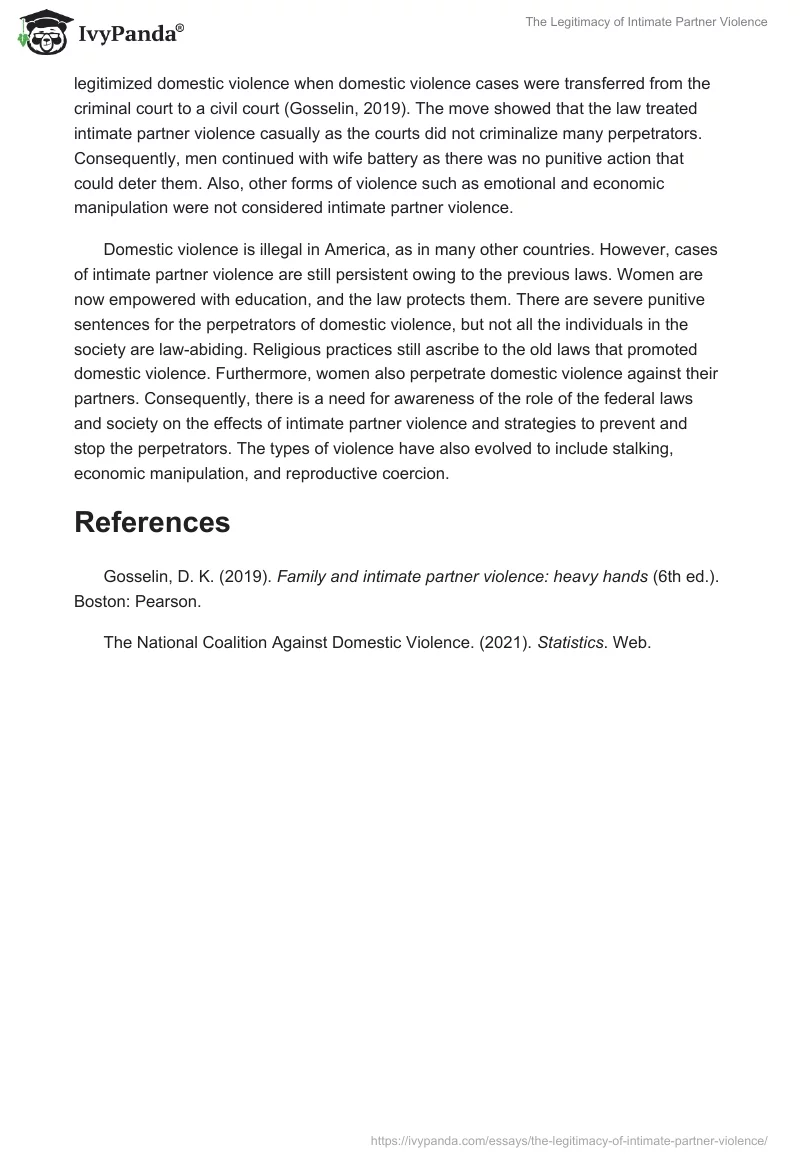Intimate partner violence (IPV) is illegal in the United States of America. However, statistics indicate that one in every four women, compared to one in nine men, experiences intimate partner violence (The National Coalition Against Domestic Violence, 2021). According to Gosselin (2019), intimate partner violence takes the form of physical assault, intimidation, battery, financial abuse, reproductive coercion, stalking, and emotional abuse. Perpetrators of domestic violence inflict harm to assert power and control through intimidation, humiliation and frightening of their partners. Society still faces challenges eradicating domestic violence due to years of negative precedence legitimizing violence against women in the United States.
Early laws in America legitimized intimate partner violence, making it challenging to eradicate the issue. For instance, the early American settlers based their laws on an old English common law called The Laws of Chastisement that allowed men to beat their wives for discipline with a rode whose circumference did not exceed the base of a man’s thumb (Gosselin, 2019, p. 187). Consequently, wife-beating became socially acceptable and at the man’s discretion. During the 15th century, the Roman Catholic church also made its own rules governing the family and marriage. The laws stipulated that a man had the power to judge and discipline a woman for spiritual alignment (Gosselin, 2019). Therefore the laws gave the man absolute power and control over women, and they practiced domestic violence indiscriminately.
Domestic violence continued throughout, and women and children suffered the most. Alabama became the first state to rescind wife battery in 1871(Gosselin, 2019, p. 188). The courts declared that a woman is under the protection of the law as any other individual in a case against an enslaved man who beat his wife. The ruling started discussions on freedom, the battered women movement that advocated against Intimate partner violence. However, a court again permitted domestic violence in North Carolina that an individual could not be indicted unless the battery resulted in permanent injury and endangered life. The law condoned domestic violence as long as it did not bother the neighbors, and thus men continued their dominance over women. Domestic violence continued, and men constantly assaulted women. The law also legitimized domestic violence when domestic violence cases were transferred from the criminal court to a civil court (Gosselin, 2019). The move showed that the law treated intimate partner violence casually as the courts did not criminalize many perpetrators. Consequently, men continued with wife battery as there was no punitive action that could deter them. Also, other forms of violence such as emotional and economic manipulation were not considered intimate partner violence.
Domestic violence is illegal in America, as in many other countries. However, cases of intimate partner violence are still persistent owing to the previous laws. Women are now empowered with education, and the law protects them. There are severe punitive sentences for the perpetrators of domestic violence, but not all the individuals in the society are law-abiding. Religious practices still ascribe to the old laws that promoted domestic violence. Furthermore, women also perpetrate domestic violence against their partners. Consequently, there is a need for awareness of the role of the federal laws and society on the effects of intimate partner violence and strategies to prevent and stop the perpetrators. The types of violence have also evolved to include stalking, economic manipulation, and reproductive coercion.
References
Gosselin, D. K. (2019). Family and intimate partner violence: heavy hands (6th ed.). Boston: Pearson.
The National Coalition Against Domestic Violence. (2021). Statistics. Web.


